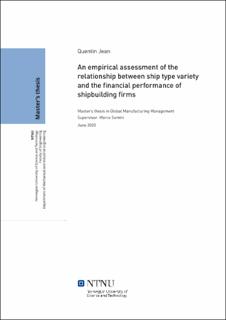| dc.description.abstract | Product variety has been largely studied for its impact on the performance of manufacturing firms. Yet, it appears that there are no such studies in the context of shipbuilding. However, product variety is also a challenge for shipbuilders, as variety becomes a strategic asset in the competitive and globalized market of shipbuilding but is also costly and challenging to achieve.
The goal of the thesis is to gain insight into the relationship between the product variety and the performance of shipyards. Specifically, this thesis focuses on the variety of ship types a shipyard produces. This thesis has two main objectives:
1. Investigate the relationship between ship type variety and the financial performance of shipbuilding firms.
2. Investigate the effect of ship type variety on the ability of shipyards to cope with market downturns.
To meet the objectives, a literature study is carried to formulate a research model and corresponding hypotheses. It is hypothesized that variety of ship types has an influence on the financial performance of shipyards. However, literature suggests that there are both positive and negative effects, which does not allow to predict if the ship type variety is profitable or not. A second hypothesis is that the ship types variety allows shipyards to better cope with a market downturn.
To test the research hypotheses, secondary data is gathered from the financial database Orbis, and the Sea-Web maritime database. The data are gathered for 22 Norwegian shipyards which are chosen based on detailed criterion. Several regression analyses are performed on the measurable variables of the dataset to test the hypothesis.
The results do not suggest that the ship type variety and the financial performance of shipyards are universally related. Which can be explained by the theory but can also result from the limitations of the model and analysis method, especially because the model might lack some predictive factors and because the sample size limits statistical significance. On the other hand, the results indicate that ship type variety is a strategic advantage when a market downturn happened. This highlights the risk dimension of the “focused” strategy of producing only one, or very few, ship type(s) to achieve high efficiency level.
This thesis contributes to the theory by exploring the relationship between ship type variety and financial performance in shipbuilding. Especially, this thesis introduces the use of two diversity measures, the Shannon index and the types count, as measures of the product variety of shipyards. Also, this thesis proposes a discussion of some methodological issues related to the use of financial performance measures to assess shipbuilding performance.
The practical implications of the thesis are that shipyards should not limit their product portfolios based on efficiency objectives, but they rather should try to keep diversified portfolios to secure their long-term stability.
This thesis concludes that further work could investigate the ideal level of variety for shipyards. Also, it suggests developing a methodology to choose whether shipyards should produce new ship type. Finally, it proposes to investigate what are the best strategies to handle variety are and how to develop them. | |
